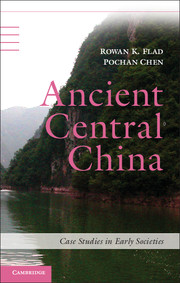Book contents
- Frontmatter
- Contents
- Figures
- Tables
- Boxes
- Acknowledgments
- 1 Introduction: Centers and Peripheries in the Ancient Yangzi River Valley
- Part I Setting the Stage
- 2 The Environment of Central China
- 3 Historiography and the Topography of Research: A History of Archaeology in Central China
- Part II Political and Cultural Topographies
- Part III Topographies of Economic Activity and Ritual
- Glossary
- Bibliography
- Index
2 - The Environment of Central China
Published online by Cambridge University Press: 05 February 2013
- Frontmatter
- Contents
- Figures
- Tables
- Boxes
- Acknowledgments
- 1 Introduction: Centers and Peripheries in the Ancient Yangzi River Valley
- Part I Setting the Stage
- 2 The Environment of Central China
- 3 Historiography and the Topography of Research: A History of Archaeology in Central China
- Part II Political and Cultural Topographies
- Part III Topographies of Economic Activity and Ritual
- Glossary
- Bibliography
- Index
Summary
Introduction
The environment of Central China sets the physical stage for various social and cultural topographies that comprise the ancient landscape. As explained earlier, Central China refers to the Upper and Middle reaches of the Yangzi River (103°–116°E longitude and 27°–33°N latitude) and encompasses parts of the modern provinces of Sichuan, Hubei, Hunan, Guizhou, and Chongqing Municipality (see Figure 2.1). Altitudes in this region range from less than 50 meters above sea level (masl) in the plains of the Middle Yangzi to peaks of more than 3,000 masl west and northwest of the Chengdu Plain and at Shennong peak in the Wu Mountains north of the Three Gorges.
Central China is dominated by a main artery – the Yangzi River – and its tributaries. The Yangzi is known in Chinese as Changjiang, or “Long River,” a name that speaks to its tremendous length (approximately 6,380 km from its source in the Himalayas to its mouth near Shanghai). The Yangzi's separate sections each has its own local designation. “Yangzi” once only referred to the last approximately 300 km near the river mouth, but nineteenth-century Western experience with exclusively this region extended “Yangzi” to the entire river in modern parlance, and we will use it this way throughout this book. Over its length, the Yangzi and its tributaries drain an area of nearly 1,127,000 km2, currently populated by more than 350 million people (Shaw 2004; Van Slyke 1988).
- Type
- Chapter
- Information
- Ancient Central ChinaCenters and Peripheries along the Yangzi River, pp. 19 - 42Publisher: Cambridge University PressPrint publication year: 2013

